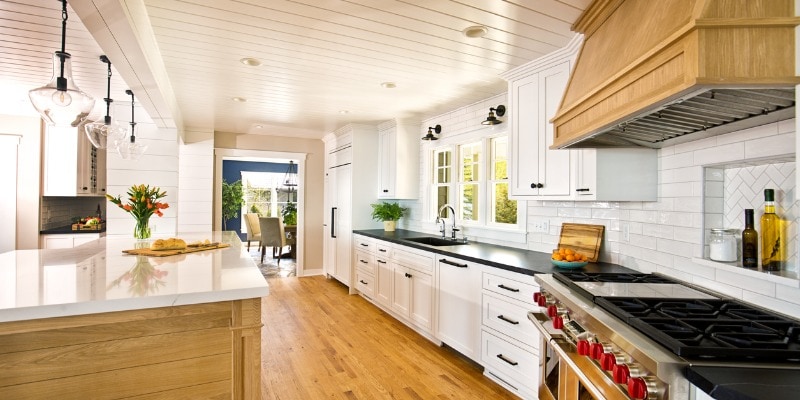well-designed kitchen is not only about aesthetics; it’s also about functionality. A crucial aspect overlooked is ventilation. A proper kitchen ventilation system is essential for maintaining air quality, removing odours, and preventing grease buildup.
In this guide, you will learn the importance of kitchen ventilation and get insights into selecting the perfect range hood for your culinary space.
Understanding the Need for Kitchen Ventilation
The kitchen is a bustling hub where cooking activities generate heat, steam, and airborne particles. These elements can accumulate without adequate ventilation, leading to discomfort, health hazards, and structural damage. A reliable kitchen ventilation system removes smoke, grease, and cooking odours, creating a cleaner, safer environment for food preparation and dining.
Types of Kitchen Ventilation Systems
When it comes to kitchen ventilation, several options are available, each catering to different needs and preferences. These include:
- Range Hoods: Mounted above the cooktop or range, range hoods capture and expel airborne contaminants through ductwork or filtration systems.
- Downdraft Ventilation: Ideal for kitchens with limited space or unconventional layouts, downdraft ventilation systems retract when not in use and rise to remove smoke and odours during cooking.
- Under-Cabinet Ventilation: Compact and discreet, under-cabinet ventilation systems fit beneath kitchen cabinets, providing efficient airflow without obstructing sightlines or design aesthetics.
- Island Hoods: Designed for kitchen islands, these hoods hang from the ceiling and vent through ductwork or recirculate air through filters, ensuring effective ventilation in open-concept spaces.
Key Considerations for Selecting a Range Hood
- Size and Capacity: Select a range hood that covers the cooking area to effectively capture smoke and grease. Consider factors like the size of your cooktop or range and the volume of cooking you typically do.
- Ventilation Power: Look for range hoods with sufficient airflow capacity measured in cubic feet per minute (CFM) to effectively remove smoke, steam, and odours from your kitchen.
- Ducted vs. Ductless: Decide whether you prefer a ducted range hood, which vents air outside through ductwork, or a ductless model, which recirculates air through filters. Ducted systems offer superior ventilation but require access to exterior walls or roofs for installation.
- Noise Levels: Consider the noise level produced by the range hood’s motor during operation, if your kitchen is open to adjacent living spaces. Opt for models with quieter operation for a comfortable cooking experience.
- Design and Style: Choose a range hood that complements your kitchen decor and reflects your style. Options include sleek stainless steel designs, modern glass panels, or custom finishes to integrate with your kitchen aesthetic.
Installation and Maintenance
Proper installation is crucial for the effectiveness and longevity of your kitchen exhaust systems. Consider hiring a professional installer to ensure accurate placement and secure ductwork connections. Regular maintenance is essential for optimal performance and to prevent grease buildup and fire hazards.
Benefits of a Well-Designed Kitchen Ventilation System
Investing in a high-quality kitchen ventilation system offers numerous benefits, including:
- Improved Air Quality: Elevate your indoor air quality with a reliable ventilation system that eliminates airborne pollutants, cooking odours, and excess moisture. Removing these contaminants creates a healthier environment for you and your loved ones, reducing the risk of respiratory issues and promoting overall well-being. Breathing cleaner air enhances comfort and productivity, allowing you to enjoy your living spaces without concern for airborne irritants.
- Enhanced Comfort: Minimise discomfort in your kitchen by reducing heat and steam buildup, creating a more pleasant environment for cooks and guests. With improved airflow and ventilation, cooking becomes an enjoyable experience, allowing chefs to focus on creating delicious meals without feeling overheated or stifled.
- Odour Control: Banish lingering cooking odours and maintain a fresh-smelling home with effective odour control. Eliminate unwanted smells and enjoy a more inviting atmosphere for dining and relaxation. A kitchen ventilation system that efficiently removes odours ensures that your home remains a pleasant space for family gatherings and entertaining guests, enhancing the overall ambience and comfort of your living environment.
- Protection Against Grease Buildup: Prevents grease accumulation on surfaces, cabinets, and appliances, reducing the risk of fire and prolonging the lifespan of kitchen fixtures.
Increased Property Value:
Investing in a well-designed kitchen with a dependable ventilation system can boost the value and desirability of your home. Prospective buyers prioritise functional and stylish kitchens, and a modern ventilation system adds to the overall appeal. An adequately ventilated kitchen signals potential buyers that the home has been well-maintained, further enhancing its perceived value and potentially commanding a higher selling price.
Conclusion
Selecting the perfect range hood for your kitchen involves considering factors like size, ventilation power, installation requirements, and design preferences. By investing in a high-quality kitchen ventilation system installation and maintenance, you can create a safer, comfortable, and inviting culinary space for cooking and entertaining. Take the time to evaluate your needs and explore the diverse range of options available to find the ideal solution that complements your lifestyle and enhances your culinary haven.
